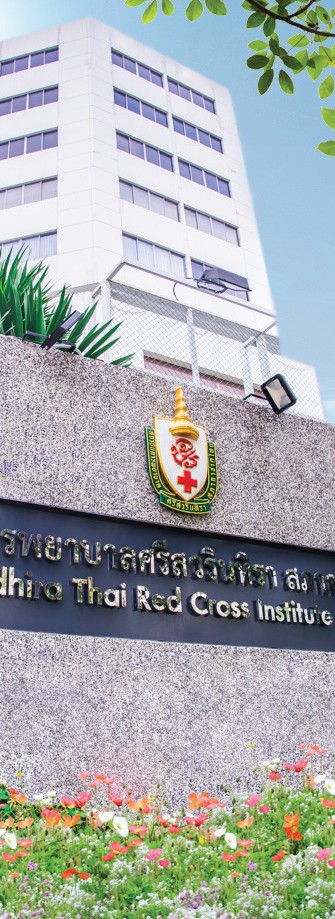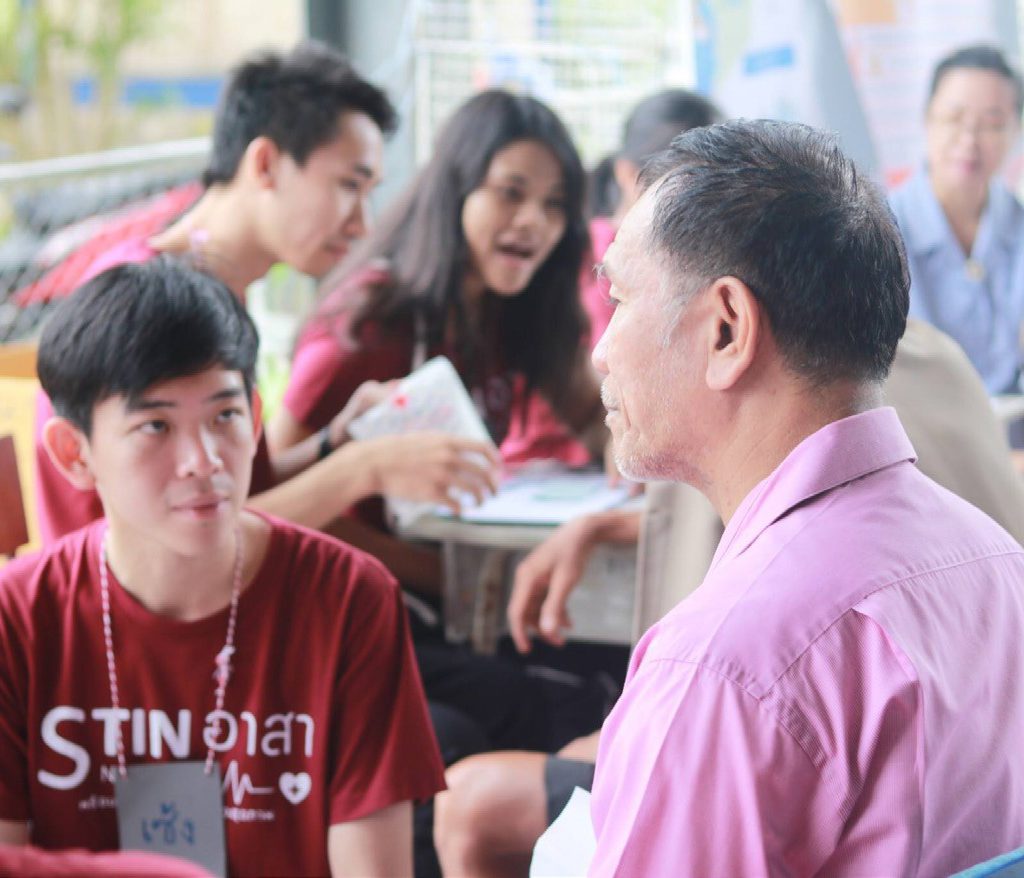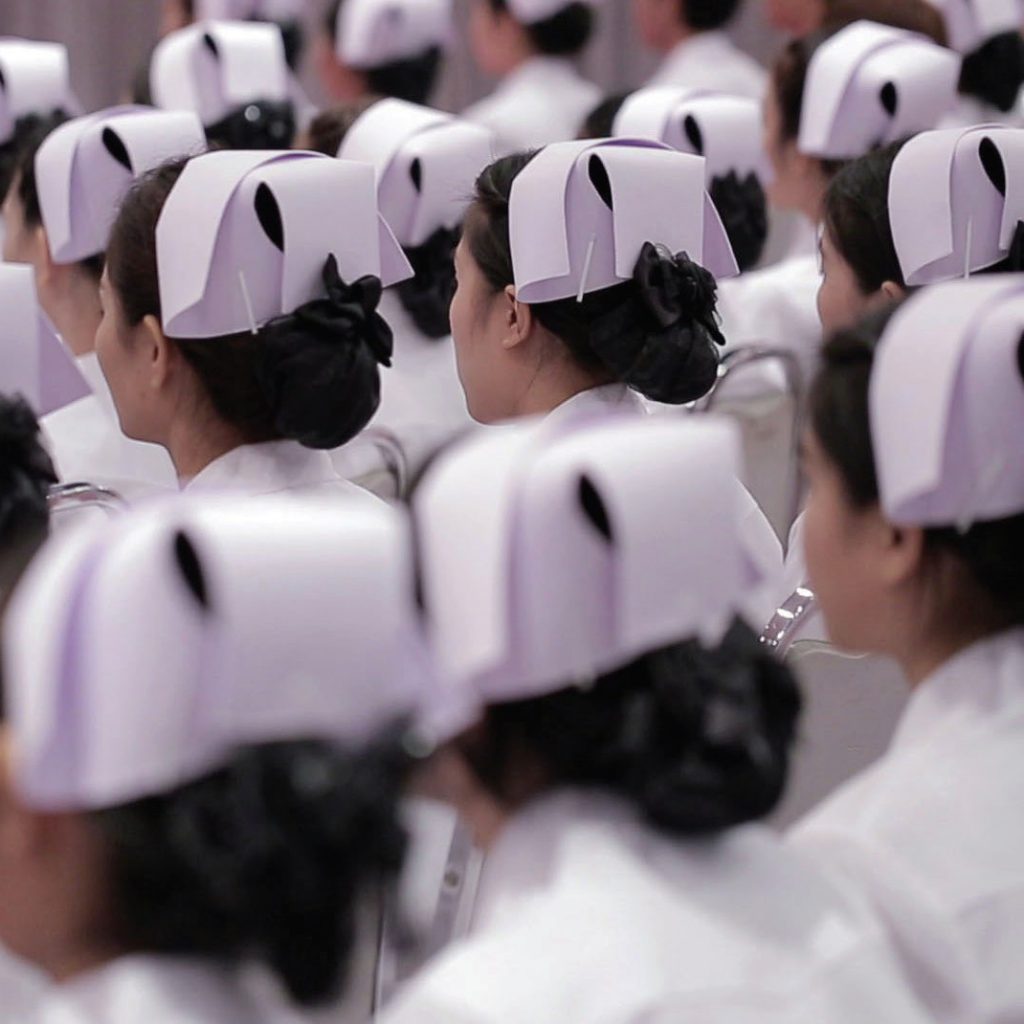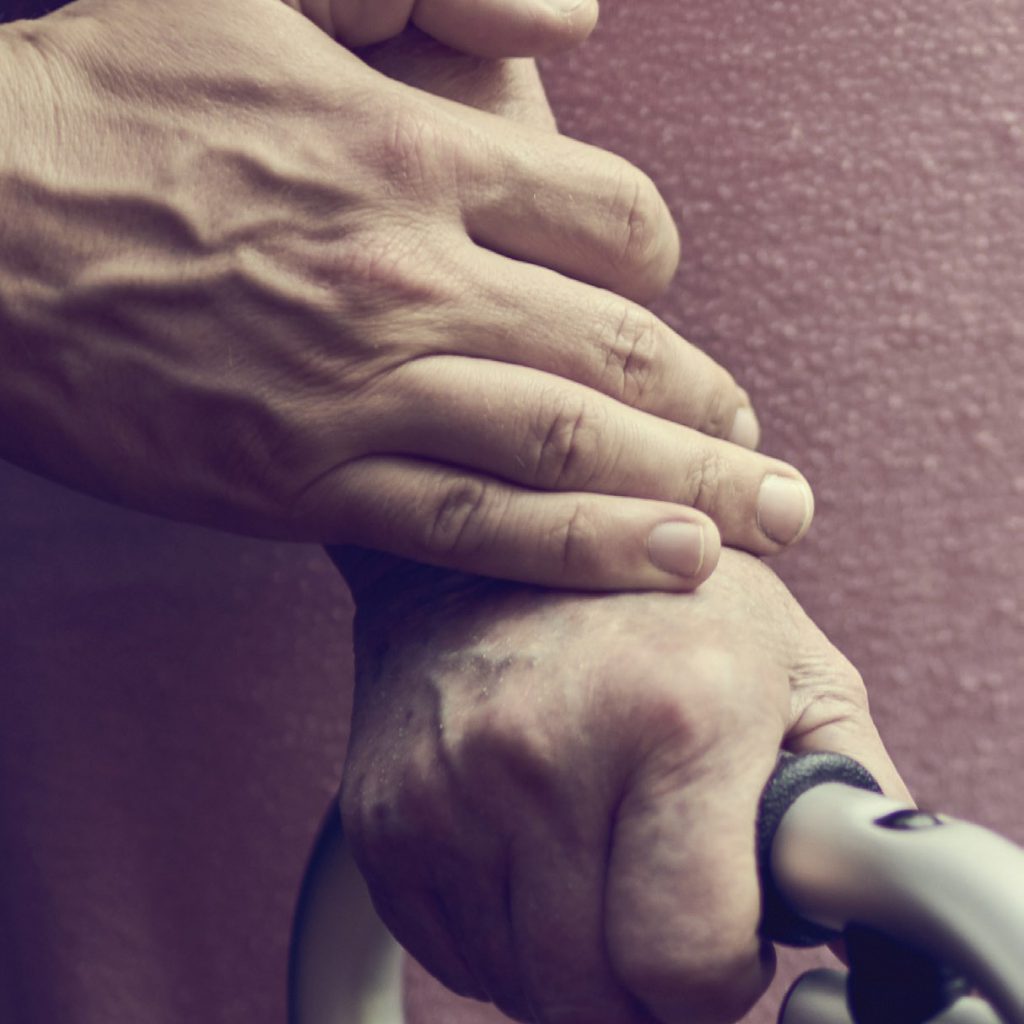THE HISTORY OF STIN

THE HISTORY OF SRISAVARINDHIRA THAI RED CROSS INSTITUTE OF NURSING
Srisavarindhira Thai Red Cross Institute of Nursing (STIN), where was previously named Thai Red Cross College of Nursing, has been initially developed from Siam Red Cross Nursing School to Thai Red Cross Society Nursing School of Midwifery and Health, Thai Red Cross College of Nursing, and then, Srisavarindhira Thai Red Cross Institute of Nursing. The institute was primarily established by His Majesty King Vajiravudh of the Siam Kingdom (King Rama VI) on 16th June 1914 C.E. It had been accounted to be the first institute in Thailand that launched the nursing curriculum, which was a one-year course and had the student exchange program with the Midwifery School of Siriraj Hospital.
When the nursing school had started operating, it was managed by the education division of King Chulalongkorn Memorial Hospital (the Royal Thai Army Nursing Department, Ministry of Defense). Later, King Chulalongkorn Memorial Hospital cancelled the education division and transferred the nursing school to be a unit of the treatment division of the hospital. The first head of the nursing school was Her Serene Highness Muntharop Kamalat.
In 1924 C.E., the nursing school expanded the curriculum to three years and accepted students with at least the 10th grade of secondary school graduation whereas the American missionary group established McCormick Nursing School in Chiang Mai and used the curriculum and examinations of Siam Red Cross Nursing School.
In 1964 C.E., the nursing school revised the curriculum to a higher standard equivalent to the international educational level called an Advanced Certificate in Nursing and Health and accepted students who graduated from the 12th grade of high school or equivalent. This curriculum was scheduled for the 3-year program plus the 6-month continuing certificate course of midwifery.
In 1968 C.E., the nursing school provided the Certificate Program in Practical Nurse which was scheduled for a 1-year study and also received students who graduated from the 10th grade of secondary school.
In 1970 C.E., the name of the nursing school was changed to Thai Red Cross College of Nursing and there was a college director as its executive. The midwifery nursing and health program has been revised to have a higher standard of diploma level. After that, His Majesty King Bhumibol Adulyadej had a royal command to issue a Royal Decree on accepting Thai Red Cross College of Nursing to be an affiliated higher education institute with Chulalongkorn University in 1971C.E. The college had also developed a new curriculum to be a Bachelor of Nursing Program with 4-year study period. In 1978 C.E., the first graduates were conferred degrees in Bachelor of Nursing Science from Chulalongkorn University.
In 1989 C.E., the Thai Red Cross Society announced the amendment of the Thai Red Cross Society (issue 37th) dated on 13th December 1989 C.E. that Thai Red Cross College of Nursing was one of the bureaus of the Thai Red Cross Society; reformed the human resource organization structure and academic administration in accordance with the missions of higher education institutions; and appointed the college director to be the director of the bureau of Thai Red Cross College of Nursing. The college continuously developed various new management of teaching, research, academic services, and student activities and founded the student club to promote the democracy and other experiences for students.
In 1993 C.E., to expand the production role of nursing personnel, the college offered two special certificate programs, including the Elderly Care Nursing Program and the Nursing Program of HIV Infectors and AIDS Patients, which each required 4-month training. Moreover, the number of college students enrolled in the Bachelor of Nursing Science Program was expanded from 170 persons per year according to the Educational Development Plan Phase 7 (1991 – 1996 C.E.) to 200 persons per year in order to be consistent with the plan to increase production and educational development in nursing sciences by the Cabinet resolution dated on 1st September 1992 C.E. In addition, there were the beginning of using computers for learning and also computer training for instructors and staff.

In 1994 C.E., the college extended the collaborative affairs with foreign countries by offering courses for foreign nurses which were scheduled for 4 to 6 months. In the same year, the college began to use computers to search for journals and textbooks in the library and also began construction of the 8-floor dormitory for nursing students in order to replace the old building which had deteriorated. The building was later named Pra-Borommakhun Building as well as the royal portrait of Her Royal Highness Princess Srinagarindra, Princess Mother, was enshrined for offering as a commemoration to her graces to the nursing profession.
In 1995 C.E., two more specialty nursing certificates–the Critical Care Nursing Program and the Nursing Program for Patients with Non-Communicable Diseases were offered for nursing graduates. Additionally, the college continuously developed the computer searching service for journals and textbooks in its library.
In 1996 C.E., the Bachelor of Nursing Science Program had been developed into the integrated curriculum and the Thai Red Cross Society appointed the cooperative committee for managing the practicum education.
Subsequently, in 1997C.E., the college was allocated for a government support budget for the construction of the classroom building, as well as a self-learning center, which was a 10-floor building consisting of large to small classrooms; nursing laboratories; a self-learning language center; and a library with information technology searching system by computers and academic service units, etc. The building was officially called Chalermphrakiat Building on the auspicious occasion of the His Majesty King Bhumibol Adulyadej’s the 6th Cycle Birthday Anniversary on 5th December 1999 C.E. afterwards.

In 1994 C.E., the college extended the collaborative affairs with foreign countries by offering courses for foreign nurses which were scheduled for 4 to 6 months. In the same year, the college began to use computers to search for journals and textbooks in the library and also began construction of the 8-floor dormitory for nursing students in order to replace the old building which had deteriorated. The building was later named Pra-Borommakhun Building as well as the royal portrait of Her Royal Highness Princess Srinagarindra, Princess Mother, was enshrined for offering as a commemoration to her graces to the nursing profession.
In 1995 C.E., two more specialty nursing certificates–the Critical Care Nursing Program and the Nursing Program for Patients with Non-Communicable Diseases were offered for nursing graduates. Additionally, the college continuously developed the computer searching service for journals and textbooks in its library.
In 1996 C.E., the Bachelor of Nursing Science Program had been developed into the integrated curriculum and the Thai Red Cross Society appointed the cooperative committee for managing the practicum education.
Subsequently, in 1997C.E., the college was allocated for a government support budget for the construction of the classroom building, as well as a self-learning center, which was a 10-floor building consisting of large to small classrooms; nursing laboratories; a self-learning language center; and a library with information technology searching system by computers and academic service units, etc. The building was officially called Chalermphrakiat Building on the auspicious occasion of the His Majesty King Bhumibol Adulyadej’s the 6th Cycle Birthday Anniversary on 5th December 1999 C.E. afterwards.
In 1998 C.E., the college had occasionally progressed for its 84 years, so the Princess Sutthathip Fund was founded to college advantage for faculties and staffs’ development and the maintenance of Sutthathip building, where was the architectural conservation building of the Thai Red Cross Society. Also, there was a regulation of the college regarding the Princess Sutthathip Awards to honor alumni who have brought fame and benefit to the college. In addition, the college began processing the faculty and student exchange program with the University of Malaspina, Canada.
In 2000 C.E., the college announced the policy of educational quality assurance using the CIPP system and 9 components of the educational quality assurance from the Ministry of University Affairs as a conceptual framework for establishing the quality assurance system. After that, the college improved the operations of quality assurance according to the quality assurance standards for teaching and learning work of Chulalongkorn University (CU-QA 84.1).
In 2002C.E., the role of college on academic services was expanded both in academic conferences and training for professional nurses, as well as academic and professional services for different age groups with problems of adjustment to health conditions and the underprivileged in their diversity of needs. In the following year, five specialty nursing courses, which were certified continuing nursing education scores by the Thailand Nursing and Midwifery Council, were offered as follows: Program of Nursing Specialty in Critical Care Nursing (Adult and Aging), Program of Nursing Specialty in Gerontological Nursing, Program of Nursing Specialty in General Nurse Practitioner (Primary Medical Care), Diploma of Sub-Specialty in Health Promotion Nursing, and Diploma of Sub-Specialty in Palliative Nursing.
In 2004 C.E., the Thai Red Cross Education and Nursing Museum was established in Chalermphrakiat Building, for the college had proceeded for 90 years. The purpose of the museum was to be a place for studying history and evolution of the nursing profession under the Thai Red Cross Society that was an important part of nursing history in Thailand.
In 2005 C.E., the college offered the Bachelor of Nursing Science Program (revised curriculum in 2004) which was developed from the Bachelor of Nursing Program (revised curriculum in 1996) to be an up-to-date curriculum and in accordance with the current situations. This new program was approved by the Thailand Nursing and Midwifery Council on the 14th February, 2005.
In 2006 C.E., the college had continually expanded the program of nursing specialty– Diploma of Sub-Specialty in Ostomy Wound Care. To meet the needs of the Thai Red Cross Society and community, the Program of Certificate in Practical Nursing (after-hour program) was launched. Moreover, a tailor-made program was provided for short-term nursing students from Aino University, Japan.
In 2007C.E., the college revised the organization structure and manpower plan approved by the Board of the Thai Red Cross Society Personnel on 11th July 2007. It aimed to facilitate the potential promotion of the college according to its missions, change supports, and be able to increase productivity and create value added to the Thai Red Cross Society and community. Additionally, the Self-Assess Language Learning Center was established. A cooperative education program in the operating rooms of King Chulalongkorn Memorial Hospital was initiated in cooperation with the Department of Nursing to improve effectively practical learning and develop the fourth-year students’ proficiency before graduation. The college also received two prizes of the CU-Quality Prize from Chulalongkorn University in 2007 C.E. Apart from that, the promotion of inmates’ children development project was initiated under the initiative of Her Royal Highness Princess Bajrakitiyabha.


In 2007C.E., the college revised the organization structure and manpower plan approved by the Board of the Thai Red Cross Society Personnel on 11th July 2007. It aimed to facilitate the potential promotion of the college according to its missions, change supports, and be able to increase productivity and create value added to the Thai Red Cross Society and community. Additionally, the Self-Assess Language Learning Center was established. A cooperative education program in the operating rooms of King Chulalongkorn Memorial Hospital was initiated in cooperation with the Department of Nursing to improve effectively practical learning and develop the fourth-year students’ proficiency before graduation. The college also received two prizes of the CU-Quality Prize from Chulalongkorn University in 2007 C.E. Apart from that, the promotion of inmates’ children development project was initiated under the initiative of Her Royal Highness Princess Bajrakitiyabha.
In 2008 C.E., there was the collaboration between the college and the Department of Nursing, King Chulalongkorn Memorial Hospital on operating the Program of Nursing Specialty in Renal Replacement Therapy (Peritoneal Dialysis), which was a project of the Department of Medical Services, Ministry of Public Health, to support patients having the end-stage of chronic renal failure with grants of the National Health Security Fund. Furthermore, there was a tailor-made program for short-term nursing students from Japanese Red Cross Kyushu International College of Nursing. In June 2008, the three nursing research centers were established including the Research Center for the Nursing of the HIV-Infected and AIDS patients, the Research Center for Gerontological Nursing, and the Research Center for Health Promotion Nursing.

In 2010C.E., the college introduced the Program of Nursing Sub-Specialty in Pain Management, the Program of Nurse Midwifery for nurses from the Lao People’s Democratic Republic. The Learning Center for Nursing Innovation was founded to collect inventions and nursing innovations created by nursing students and instructors, to be a learning source of nursing innovation for nursing students, personnel and interested people. In addition, there were teaching staff and student exchange programs with five-country partnerships, including China, Japan, Korea, Singapore and Sweden.

In 2010C.E., the college introduced the Program of Nursing Sub-Specialty in Pain Management, the Program of Nurse Midwifery for nurses from the Lao People’s Democratic Republic. The Learning Center for Nursing Innovation was founded to collect inventions and nursing innovations created by nursing students and instructors, to be a learning source of nursing innovation for nursing students, personnel and interested people. In addition, there were teaching staff and student exchange programs with five-country partnerships, including China, Japan, Korea, Singapore and Sweden.
In 2011 C.E, the Center of Disaster-Related Health Training was established to allocate knowledge and to develop essential healthcare skills in disasters for students and the public, as well as determining knowledge on disaster nursing.
In 2012 C.E., the college revised the Bachelor of Nursing Science Program according to the standardized framework in Nursing Science so that the curriculum would be consistent with the current situation, focused on learning outcomes, and led to modification of learning processes. This curriculum was approved by Chulalongkorn University, and certified by the Office of the Higher Education Commission, as well as the Thailand Nursing and Midwifery Council.


In 2011 C.E, the Center of Disaster-Related Health Training was established to allocate knowledge and to develop essential healthcare skills in disasters for students and the public, as well as determining knowledge on disaster nursing.
In 2012 C.E., the college revised the Bachelor of Nursing Science Program according to the standardized framework in Nursing Science so that the curriculum would be consistent with the current situation, focused on learning outcomes, and led to modification of learning processes. This curriculum was approved by Chulalongkorn University, and certified by the Office of the Higher Education Commission, as well as the Thailand Nursing and Midwifery Council.
In 2013 C.E., the college offered the Program of Nursing Specialty in Science and Art of Teaching in Nursing, certified by the Thailand Nursing and Midwifery Council, for supporting the professional development of nursing personnel in educational institutions to have knowledge and capacity to teach nursing students, regarding the certified education criteria of the council.
In 2014 C.E., It was the 100th anniversary of the founding of Thai Red Cross College of Nursing. The college held the first international academic conference in collaboration with the Red Cross networks, such as the ICRC, IFRC, the Japanese Red Cross, Swedish Red Cross, etc. which was called The First Red Cross/Red Crescent International Nursing Conference on “Disaster Nursing, Humanitarian Emergency Response, and Nursing Trends”. In addition, the Program of Nursing Specialty in Stroke Patients was initially offered.
In 2016 C.E., the college received royal grace from Her Royal Highness Princess Maha Chakri Sirindhorn, the executive Vice President of the Thai Red Cross Society, to lay a foundation stone for the Sirindhanusorn 60th Anniversary Building, twenty-five floor school building and dormitory, on 3rd June 2016. This building was scheduled for completion in 2019. Additionally, the college received the accreditation on the Bachelor of Nursing Science Program from the Thailand Nursing and Midwifery Council for a maximum duration of the five-accreditation academic years (the academic year 2016 – 2020). Moreover, the college was raised the status to be Srisavarindhira Thai Red Cross Institute of Nursing under the Srisavarindhira Thai Red Cross Institute of Nursing Act, 2559 B.E. (2016 C.E.) announced in the Government Gazette on 26th December 2016 to be a higher educational institution on nursing and a juristic person. The operation of the institute is under the supervision of the Ministry of Higher Education, Science, Research and Innovation and the institute is also under the support of the Thai Red Cross Society. The objectives of establishing the institute include educational management, research performance, academic and advanced professional promotion and development on nursing and other relevant sciences, academic services, art and cultural preservation based on the missions of the higher educational institution, and maintenance of the Thai Red Cross identity in order to be beneficial to community and society and result in developing country.
In 2017 C.E., the Bachelor of Nursing Science Program was revised once again, and accredited by the Thailand Nursing and Midwifery Council on 11th August 2017. The development of the program was considered different effects on society, including economic, social, cultural, political and needs of public health services as guidelines in curriculum development and quality of graduates in accordance with the changing contexts. Also, it would still maintain the significant identities of the Red Cross for being talented people, happy, humane, compassionate, voluntary, and able to manage disaster risk by considering people and the disadvantaged.
In 2018 C.E., the institute had developed a 10-year development plan of the institution (2018 – 2027 C.E.), a 4-year development plan of the institution (fiscal year 2562 – 2565 B.E.) and an institutional action plan for the fiscal year 2019. The first graduation ceremony was held as Srisavarindhira Thai Red Cross Institute of Nursing on 18th October 2018.
